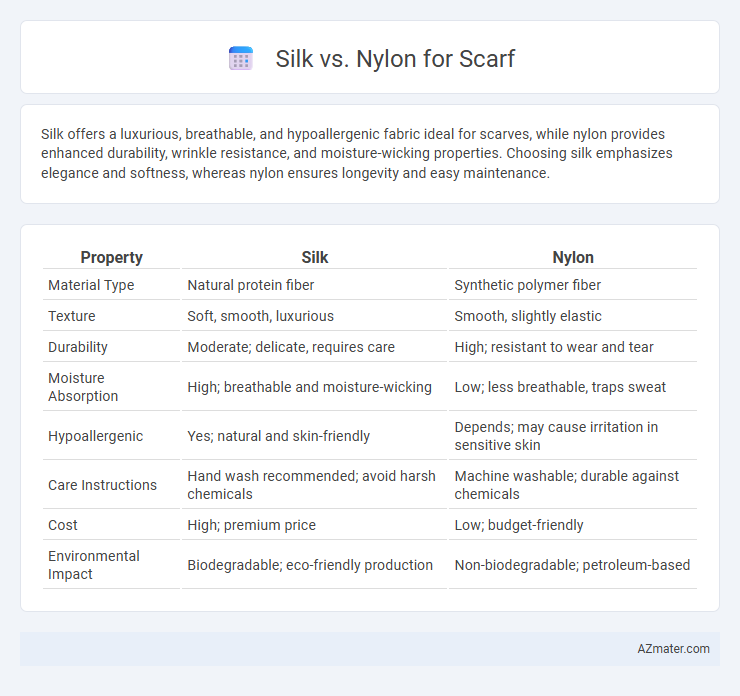Silk offers a luxurious, breathable, and hypoallergenic fabric ideal for scarves, while nylon provides enhanced durability, wrinkle resistance, and moisture-wicking properties. Choosing silk emphasizes elegance and softness, whereas nylon ensures longevity and easy maintenance.
Table of Comparison
| Property | Silk | Nylon |
|---|---|---|
| Material Type | Natural protein fiber | Synthetic polymer fiber |
| Texture | Soft, smooth, luxurious | Smooth, slightly elastic |
| Durability | Moderate; delicate, requires care | High; resistant to wear and tear |
| Moisture Absorption | High; breathable and moisture-wicking | Low; less breathable, traps sweat |
| Hypoallergenic | Yes; natural and skin-friendly | Depends; may cause irritation in sensitive skin |
| Care Instructions | Hand wash recommended; avoid harsh chemicals | Machine washable; durable against chemicals |
| Cost | High; premium price | Low; budget-friendly |
| Environmental Impact | Biodegradable; eco-friendly production | Non-biodegradable; petroleum-based |
Introduction to Silk and Nylon Scarves
Silk scarves offer a luxurious, smooth texture with natural hypoallergenic properties, making them ideal for sensitive skin and elegant styling. Nylon scarves provide excellent durability, moisture resistance, and affordability, suited for everyday wear and active use. Both materials vary significantly in weight, breathability, and maintenance requirements, influencing comfort and longevity in fashion accessories.
Origins and Production Methods
Silk, derived from the cocoons of the Bombyx mori silkworm in ancient China, undergoes a delicate reeling and weaving process that preserves its natural protein fibers, resulting in a lustrous, smooth fabric. Nylon, a synthetic polymer invented by Wallace Carothers at DuPont in 1935, is produced through a chemical process called polymerization, where raw materials like coal and petroleum are transformed into strong, elastic fibers via extrusion and spinning. The organic origin and labor-intensive production of silk contrast sharply with nylon's man-made, industrial manufacturing, affecting texture, durability, and environmental footprint.
Texture and Comfort Comparison
Silk scarves offer a naturally smooth, soft texture that feels luxurious and breathable against the skin, providing excellent moisture-wicking properties that enhance comfort in various climates. Nylon, while synthetic, provides a lightweight and durable texture but lacks the natural breathability of silk, often resulting in less comfort during prolonged wear. The hypoallergenic and temperature-regulating qualities of silk generally make it a preferred choice for softness and overall comfort in scarves.
Durability and Longevity
Nylon scarves offer superior durability compared to silk, resisting tears, abrasion, and moisture more effectively, which extends their lifespan in everyday use. Silk, while luxurious and soft, is more delicate and prone to damage from friction, exposure to sunlight, and washing, leading to faster wear and fading over time. Choosing nylon ensures a longer-lasting scarf ideal for frequent wear, whereas silk requires gentle care to maintain its elegance.
Breathability and Temperature Regulation
Silk scarves offer superior breathability due to their natural protein fibers, allowing better air circulation and moisture wicking, which helps maintain comfort in varying temperatures. Nylon, a synthetic fabric, tends to trap heat and moisture, reducing breathability and causing discomfort in warm conditions. For temperature regulation, silk adapts to body heat and ambient conditions, providing a cooling effect in heat and warmth in cooler weather, whereas nylon lacks this dynamic thermal response.
Color Retention and Design Options
Silk scarves offer superior color retention due to their natural protein fibers, which absorb dye deeply and maintain vibrancy over time. Nylon scarves, made from synthetic fibers, may fade more quickly with repeated washing and exposure to sunlight, affecting the longevity of their colors. Silk also provides more intricate design options, as its smooth texture allows for finer patterns and detailed prints compared to the typically less detailed designs on nylon scarves.
Maintenance and Care Requirements
Silk scarves require gentle hand washing with mild detergents and should be air-dried away from direct sunlight to prevent fabric damage and color fading. Nylon scarves are more durable, allowing machine washing on a gentle cycle and faster drying times without significant wear. Proper storage for both materials involves keeping scarves in a cool, dry place to avoid moisture buildup and maintain fabric integrity.
Environmental Impact and Sustainability
Silk, a natural fiber derived from silkworms, is biodegradable and renewable, making it more environmentally sustainable compared to nylon, a synthetic polymer made from petrochemicals. The production of nylon involves significant greenhouse gas emissions and non-renewable resource consumption, contributing to environmental pollution. Choosing silk scarves supports reduced ecological footprint through biodegradability and lower synthetic waste, aligning with sustainable fashion practices.
Price Range and Affordability
Silk scarves typically range from $50 to $300 or more, reflecting their luxury status and natural fiber quality, while nylon scarves are generally priced between $10 and $50 due to their synthetic composition and mass production. Affordability favors nylon, making it an economical choice for everyday wear, whereas silk offers a premium feel and durability worth the higher investment. Consumers seeking budget-friendly options often prefer nylon, while those prioritizing elegance and breathability opt for silk despite the higher cost.
Choosing the Best Scarf Material for Your Needs
Silk scarves offer a luxurious feel, natural breathability, and hypoallergenic properties, making them ideal for sensitive skin and elegant occasions. Nylon scarves provide greater durability, wrinkle resistance, and affordability, which suits active lifestyles and casual wear. Choosing the best scarf material depends on whether you prioritize softness and elegance or strength and budget-friendliness.

Infographic: Silk vs Nylon for Scarf
 azmater.com
azmater.com